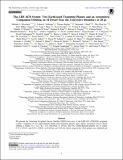The LHS 1678 system : two earth-sized transiting planets and an astrometric companion orbiting an M dwarf near the convective boundary at 20 pc
Abstract
We present the Transiting Exoplanet Survey Satellite (TESS) discovery of the LHS 1678 (TOI-696) exoplanet system, comprised of two approximately Earth-sized transiting planets and a likely astrometric brown dwarf orbiting a bright (VJ = 12.5, Ks = 8.3) M2 dwarf at 19.9 pc. The two TESS-detected planets are of radius 0.70 ± 0.04 R⊕ and 0.98 ± 0.06 R⊕ in 0.86 day and 3.69 day orbits, respectively. Both planets are validated and characterized via ground-based follow-up observations. High Accuracy Radial Velocity Planet Searcher RV monitoring yields 97.7 percentile mass upper limits of 0.35 M⊕ and 1.4 M⊕ for planets b and c, respectively. The astrometric companion detected by the Cerro Tololo Inter-American Observatory/Small and Moderate Aperture Telescope System 0.9 m has an orbital period on the order of decades and is undetected by other means. Additional ground-based observations constrain the companion to being a high-mass brown dwarf or smaller. Each planet is of unique interest; the inner planet has an ultra-short period, and the outer planet is in the Venus zone. Both are promising targets for atmospheric characterization with the James Webb Space Telescope and mass measurements via extreme-precision radial velocity. A third planet candidate of radius 0.9 ± 0.1 R⊕ in a 4.97 day orbit is also identified in multicycle TESS data for validation in future work. The host star is associated with an observed gap in the lower main sequence of the Hertzsprung–Russell diagram. This gap is tied to the transition from partially to fully convective interiors in M dwarfs, and the effect of the associated stellar astrophysics on exoplanet evolution is currently unknown. The culmination of these system properties makes LHS 1678 a unique, compelling playground for comparative exoplanet science and understanding the formation and evolution of small, short-period exoplanets orbiting low-mass stars.
Citation
Silverstein , M L , Schlieder , J E , Barclay , T , Hord , B J , Jao , W-C , Vrijmoet , E H , Henry , T J , Cloutier , R , Kostov , V B , Kruse , E , Winters , J G , Irwin , J M , Kane , S R , Stassun , K G , Huang , C , Kunimoto , M , Tey , E , Vanderburg , A , Astudillo-Defru , N , Bonfils , X , Brasseur , C E , Charbonneau , D , Ciardi , D R , Collins , K A , Collins , K I , Conti , D M , Crossfield , I J M , Daylan , T , Doty , J P , Dressing , C D , Gilbert , E A , Horne , K , Jenkins , J M , Latham , D W , Mann , A W , Matthews , E , Paredes , L A , Quinn , S N , Ricker , G R , Schwarz , R P , Seager , S , Sefako , R , Shporer , A , Smith , J C , Stockdale , C , Tan , T-G , Torres , G , Twicken , J D , Vanderspek , R & Wang , G 2022 , ' The LHS 1678 system : two earth-sized transiting planets and an astrometric companion orbiting an M dwarf near the convective boundary at 20 pc ' , Astronomical Journal , vol. 163 , no. 4 , 151 . https://doi.org/10.3847/1538-3881/ac32e3
Publication
Astronomical Journal
Status
Peer reviewed
ISSN
0004-6256Type
Journal article
Description
Funding: The MEarth Team gratefully acknowledges funding from the David and Lucile Packard Fellowship for Science and Engineering (awarded to D.C.). This material is based upon work supported by the National Science Foundation under grants AST-0807690, AST-1109468, AST-1004488 (Alan T. Waterman Award), and AST-1616624, and upon work supported by the National Aeronautics and Space Administration under Grant No. 80NSSC18K0476 issued through the XRP Program. This work is made possible by a grant from the John Templeton Foundation. N. A.-D. acknowledges the support of FONDECYT project 3180063. TD acknowledges support from MIT’s Kavli Institute as a Kavli postdoctoral fellow. KH acknowledges support from STFC grant ST/R000824/1. E.A.G. thanks the LSSTC Data Science Fellowship Program, which is funded by LSSTC, NSF Cybertraining Grant #1829740, the Brinson Foundation, and the Moore Foundation; The material is based upon work supported by NASA under award number 80GSFC21M0002. This work was supported by the lead author’s appointment to the NASA Postdoctoral Program at the Goddard Space Flight Center, administered by Universities Space Research Association under contract with NASACollections
Items in the St Andrews Research Repository are protected by copyright, with all rights reserved, unless otherwise indicated.

